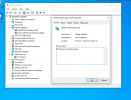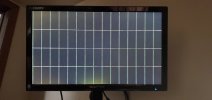I've recently gotten a ThinkCentre m90n-IoT and I figured it would be fun to throw proxmox on it and use it as a portable lab / testbench device, one thing I really wanted to get working was GPU passthrough of the Intel UHD 620 so that way it could also be plugged into a monitor and used as a "desktop" if needed with a few VMs. Here has been my experience thus far:
I originally started with 6.3 but the graphics card would not output a picture when set to a windows 10 or a debian 10 vm so I went back and started again with the 6.2-1 installer as I haven't upgraded my own server to 6.3 yet so I figured I'd start there and see if I could get any success.
After installation I ran "lspci -nnk | grep "VGA\|Audio""
Edited /etc/modules-load.d/vfio.conf
Edited /etc/modprobe.d/vfio.conf
Ran "update-initramfs -u -k all" then edited grub
Ran "update-grub" and rebooted. Set up a Windows 10 VM
Upon starting the screen goes black, followed shortly by a "no signal". I can RDP in just fine, ran all updates and no errors with the graphics card shows up.

I decide to then update proxmox (apt update and upgrade) and reboot, no change. I set up a debian VM to see if there's any difference there, initially I use a VirtIO-GPU to run the install, then I set the graphics card as the primary gpu and remove the VirtIO-GPU.
I don't get a black screen, but a grid-like glitch pattern

I grabbed the xorg (https://pastebin.com/0N9WMsHm) and the syslog (https://pastebin.com/k1U3tVDi) , but I'm a little out of my element here.
I went ahead and upgraded to 6.3 and no changes in either VM.. Does anyone have any tips I can try? Thank you!
I originally started with 6.3 but the graphics card would not output a picture when set to a windows 10 or a debian 10 vm so I went back and started again with the 6.2-1 installer as I haven't upgraded my own server to 6.3 yet so I figured I'd start there and see if I could get any success.
After installation I ran "lspci -nnk | grep "VGA\|Audio""
00:02.0 VGA compatible controller [0300]: Intel Corporation UHD Graphics 620 (Whiskey Lake) [8086:3ea0] (rev 02)
00:1f.3 Audio device [0403]: Intel Corporation Cannon Point-LP High Definition Audio Controller [8086:9dc8] (rev 30)
Subsystem: Lenovo Cannon Point-LP High Definition Audio Controller [17aa:314d]
Edited /etc/modules-load.d/vfio.conf
vfio
vfio_iommu_type1
vfio_pci
vfio_virqfd
Edited /etc/modprobe.d/vfio.conf
options vfio-pci ids=8086:3ea0,8086:9dc8
Ran "update-initramfs -u -k all" then edited grub
...
GRUB_CMDLINE_LINUX_DEFAULT="quiet intel_iommu=on"
....
Ran "update-grub" and rebooted. Set up a Windows 10 VM
After a successful install, I enabled RDP, shut down and changed the configbios: ovmf
bootdisk: ide0
cores: 2
cpu: host
efidisk0: local-lvm:vm-100-disk-1,size=4M
hostpci0: 00:02,pcie=1
hostpci1: 00:1f,pcie=1
ide0: local-lvm:vm-100-disk-0,size=32G
ide2: local:iso/Windows10.iso,media=cdrom
machine: q35
memory: 2048
name: fuhs
net0: e1000=62:EEC
5:CD:A1,bridge=vmbr0,firewall=1
numa: 0
ostype: win10
scsihw: virtio-scsi-pci
smbios1: uuid=c3e369c5-40d8-4058-b8b8-0d63fb9943a7
sockets: 1
vmgenid: 68796aa6-cd03-4657-8d7b-f919593a180e
bios: ovmf
bootdisk: ide0
cores: 2
cpu: host
efidisk0: local-lvm:vm-100-disk-1,size=4M
hostpci0: 00:02,pcie=1,x-vga=1
hostpci1: 00:1f,pcie=1
ide0: local-lvm:vm-100-disk-0,size=32G
ide2: local:iso/Windows10.iso,media=cdrom
machine: q35
memory: 2048
name: fuhs
net0: e1000=62:EEC
5:CD:A1,bridge=vmbr0,firewall=1
numa: 0
ostype: win10
scsihw: virtio-scsi-pci
smbios1: uuid=c3e369c5-40d8-4058-b8b8-0d63fb9943a7
sockets: 1
vga: none
vmgenid: 68796aa6-cd03-4657-8d7b-f919593a180e
Upon starting the screen goes black, followed shortly by a "no signal". I can RDP in just fine, ran all updates and no errors with the graphics card shows up.

I decide to then update proxmox (apt update and upgrade) and reboot, no change. I set up a debian VM to see if there's any difference there, initially I use a VirtIO-GPU to run the install, then I set the graphics card as the primary gpu and remove the VirtIO-GPU.
bios: ovmf
bootdisk: scsi0
cores: 2
cpu: host
efidisk0: local-lvm:vm-101-disk-1,size=4M
hostpci0: 00:02,pcie=1,x-vga=1
hostpci1: 00:1f,pcie=1
ide2: none,media=cdrom
machine: q35
memory: 2048
name: roh
net0: virtio=BA:CF:13:30:30:E0,bridge=vmbr0,firewall=1
numa: 0
ostype: l26
scsi0: local-lvm:vm-101-disk-0,size=32G
scsihw: virtio-scsi-pci
smbios1: uuid=d5ee8914-c6b3-45b3-9170-569e3188e03a
sockets: 1
vga: none
vmgenid: 60901ad3-c34c-41d6-aea1-009e64398986
I don't get a black screen, but a grid-like glitch pattern

I grabbed the xorg (https://pastebin.com/0N9WMsHm) and the syslog (https://pastebin.com/k1U3tVDi) , but I'm a little out of my element here.
I went ahead and upgraded to 6.3 and no changes in either VM.. Does anyone have any tips I can try? Thank you!

